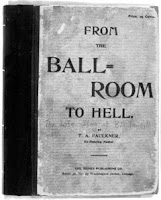This is part two of a series of articles charting highlights of partner dancing in the twentieth century. It was originally commissioned and published by Vintage Life Magazine, November 2015* with a new article following each month for each subsequent decade.
As we discovered last month, in certain ‘Society’ circles there was a desire to throw off the constraints of the Waltz, and embrace more improvised elements as found in Ragtime music. As Morgan Howland states on his blog covering Twentieth Century dance crazes: “The new American dancing fads brought popular culture away from the Victorian age ideals of perpetual toil, work and duty”.
 |
| Modern Dancing manual, 1914. |
Also, unforgettably, The Great War (1914-1918), which brought with it massive social change. As communities coped with the departure of so many men, women were required to step into many varied roles to keep the country moving. Taking up manufacturing and driving roles, becoming bus conductors - previously unthinkable for ladies! The War Effort necessitated thrift, industry, collective responsibility - a “Home Front”. The Women’s Institute was founded in Britain in 1915.
In Victor Sylvester’s book 'Modern Ballroom Dancing' (published in 1927) he explains: "When war came, the most popular form of relaxation for the men on leave was a dance”. Hardly surprising, given that it provided welcome human contact and distraction from their experiences in war. The Foxtrot was also supremely accessible. The men were required to begin with a slow walk - more or less marching, one step every other beat; and then progress, once ready, into a ‘trot’ or run, one step each beat.
 |
| Dance Superstars Vernon & Irene Castle |
Though the origins of the name ‘Foxtrot’ are disputed - the dance is said to have made its breakthrough in 1914, propagated most notably by the aforementioned Castles. The 1914 musical “Watch Your Step” starred the couple, showcased the Foxtrot and was also Irving Berlin’s debut musical score. It is undoubtedly one of the key dance legacies of this decade.
The delightfully quaint events we now know as ‘tea dances’ also began to take shape during this decade. Imagine a time when dancers were required to remain nine inches apart, and if found dancing too close, could be ‘ejected’ from the dancehall. It is no understatement to say that much of partner dancing - done for purely hedonistic reasons - was frowned upon by those upholding traditional values. As with each generation, there are those that challenge the status quo with free spirited expression. Here were young, un-chaperoned single women, in mixed company, 'acting out' songs like “snug up close to your lady” with different male dance partners during one evening. Quite a departure from traditional, restrained conduct!
The National War Savings Committee issued the following warning in 1915:
“To dress extravagantly in wartime is worse than bad form, it is unpatriotic”.
 |
| World War One Centenary event, 2014. |
 |
| Stepping back 100 years |
Next month: The 1920s.















